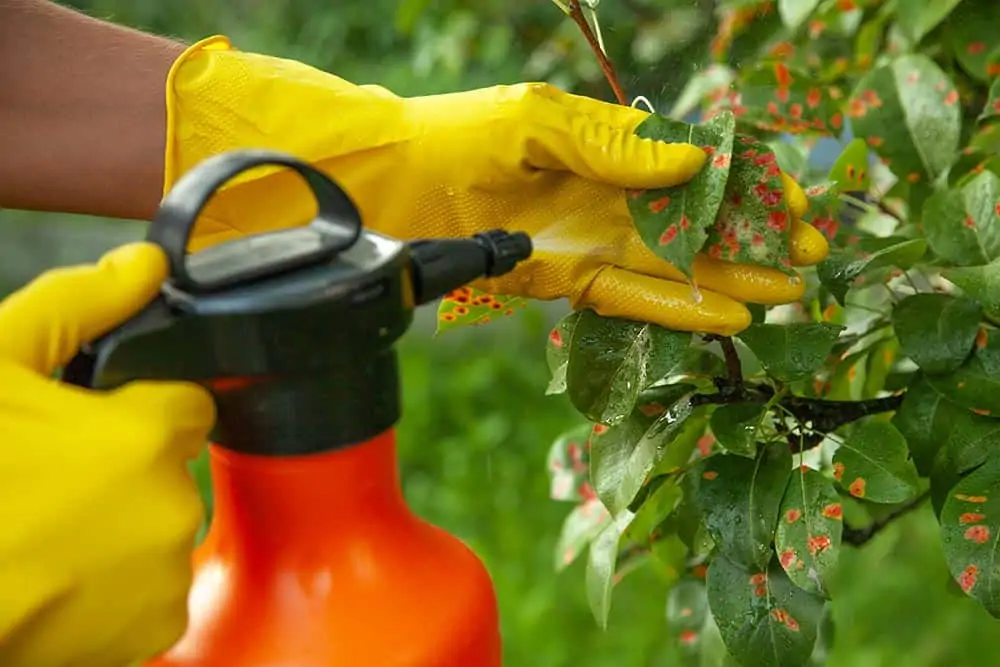Your plants and crops are growing healthily and a good outcome is looking promising. That is until you notice fungi growing on some of the leaves of various plants.
These fungi can cause economic damage to farmers and destroy ornamental plants in your back yard. Furthermore, they can become very dangerous to the health of animals and humans.
To fight this parasitic fungus, you will need fungicide, also known as antimycotic. This toxic substance works to kill or inhibit the fungi’s growth. Once the fungicide is applied, you just have to wait for it to work and destroy the fungus.
However, you may be wondering whether a downpour of rain could wash away the fungicide, leaving you and your plants in square one.

The answer to whether rain can wash away fungicide depends on the type of fungicide. Some require a little water for the application to work sufficiently and, while a little water usually doesn’t do much harm, an excessive amount can impede the fungicide’s process.
Fungicides that contain highly systemic materials, such as phosphite, need to be absorbed into the plant for ½ a day or more. DMIs (DeMethylation Inhibitors) and strobilurins or products such as Top Gard or Absolut have some sort of systemic activity but are not as systemic as phosphites.
However, they still need some time to become effective such as several hours or so. DMIs and strobis work largely as protectants rather than being systemic.
Protectant fungicides are contact materials that work mostly on the outside of the plant while systemic fungicide is absorbed by the plant. Therefore, systemic fungicides are less likely to be washed off by rain compared to protectant fungicides which sit on the outside of the plant.
It is believed that one inch of rainfall can remove around 50% of a protectant residue and two inches can remove most of the spray residue. Newer fungicides such as Bravo Weather and Dithane Rainshield have a thicker application that is more resistant to rain.
Fungicides and formulations differ widely, especially on their ability to stick to plant surfaces. It is best to research whether your fungicide is systemic or protectant to get the best idea.
Does copper fungicide wash off in the rain?
Fungal diseases can become a huge problem for gardeners and farmers, especially when the weather is warmer and wetter. To ward off these fungal infections, many use copper fungicides.
This is especially popular with those who don’t like to use chemical fungicides. However, it is important to know when to use copper fungicide and whether rain can destroy its fungal killing properties.
Copper fungicide works best when a plant is developing a fungal disease. It doesn’t work on existing fungal diseases, unfortunately. Therefore, it is best to use this fungicide as soon as you notice any signs of a fungus growing on your plants.
It is recommended that plants are sprayed with a copper fungicide when there is a forecast of around 12 hours afterward of dry weather. This dry weather will allow the copper fungicide to fight the fungal disease.
Copper fungicide can be washed off by rainfall, especially prolonged rainfall. Therefore, it is important that you apply it during spring or summer when there is less probability of being washed off by rain.
A general rule of thumb is that less than 1 inch of rain shouldn’t significantly affect the copper residues. 1 to 2 inches of rain can halve the residue so you should then cut the number of days between sprays by half.
Over 2 inches of rain will remove the majority of the spray residue. It is recommended that you spray as soon as possible after rain. You can use a spreader or sticker to reduce the risk of wash-off and see the copper fungicide work effectively.
How long does fungicide need to be on before rain?
This can depend on the type of fungicide. Protectant and systemic fungicides vary because of how their processes function.
As highly systemic materials such as phosphite need to be absorbed into plants, you should apply it and wait around ½ a day for it to work properly. Less systemic materials would still need around several hours of ½ a day before any rainfall.
A surfactant, such as an 80/20, can increase the process of these materials and you may be able to add it just an hour or two before rainfall.
Protectant materials are more prone to being washed off by rain because they stick to the outside of the plant rather than being absorbed. A downfall of rain, less than one hour after spraying, can result in this fungicide being largely ineffective.
If rain falls on a protectant spray within 24 hours of being applied, it will most likely reduce its effectiveness to some extent. Therefore, the more hours before rainfall, the better control the fungicide will supply.
It is advised that all fungicides should be applied before any rain. If you have to spray after rainfall, the DMI/Strobi combinations are the best option.

